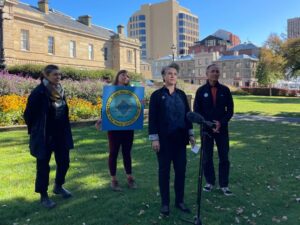Advisers, Au Pairs and Axes
- The nanny state of childcare
- Axing the taxes
- Financial planners free again
- TAI in the media
- Infographic
- Weekly updates from TAI
The nanny state of childcare
The anticipated Productivity Commission report into Childcare, flagged before the last federal election by Tony Abbott to negate childcare affordability as an election issue was released this week. Not surprisingly, the draft report recommended that the existing dual payment structure (one means tested, the other not) be replaced by a single means tested payment.
There had been strong lobbying for nannies to be included as approved childcare providers for government funding, so it was not surprising to see this proposal in the draft report. What is surprising is the inclusion of grandparents too. Both nannies and grandparents would be required to complete certified childcare qualifications. This change raises further questions about the practicalities of ensuring compliance with national standards of service delivery and quality.
A childcare worker may look after six or more children depending on their ages, where a nanny may only have one child to look after. Adding nannies to the childcare sector would therefore result in a productivity reduction in the childcare sector. People are free to make such arrangements, but we can question giving subsidies for less productive solutions. The terms of reference stipulated that recommended changes are to be made within existing funding.
In releasing the draft report, the Productivity Commission has argued that funding changes will provide more support to low and middle income households, and less support to high income households. Initial responses from some have raised concerns about the decrease in support for households earning over $160,000 a year.
The adjustment of assistance payments to help those on lower incomes was proposed in The Australia Institute’s submission. Such a focus is also evident in the Productivity Commission ruling out tax deductibility for childcare costs – a policy which would have favoured high income families more than it would benefit low and middle income families.
There are welcome reforms in the draft report alongside some questionable proposals.
Axing the taxes
It’s been a busy few weeks in politics.
The new Senate was put straight to work as the government tried to rush through the repeal of both the carbon and mining taxes. While the government eventually succeeded in repealing the carbon tax, it has so far failed to axe the mining tax.
The government came to power on a wave of rhetoric about the carbon tax – a “wrecking ball” to the economy and a “$550 burden” on household budgets. However, just as introducing the carbon tax didn’t raise the cost of lamb to $100, (the price actually went down 13 per cent), removing it will not have a noticeable impact on the cost of living.
The repeal of the carbon tax is a step backwards for Australia’s climate policy and outs us as the pariah of international climate action. Despite it being effective (it has reduced emissions by 39 million tonnes CO2e) with minimal economic disruption, the carbon tax had to go; the victim of politicking over policy.
The Renewable Energy Target (RET), the Climate Change Authority (CCA) and the Clean Energy Finance Corporation (CEFC) have remained. These initiatives have been successful in encouraging investment in renewable technology. The CEFC has generated $3 billion in renewable and energy efficiency investment while the RET doubled renewable energy capacity between 2002 and 2012. The continued success of renewable energy investment is in doubt. Just this week, Pacific Hydro said they were holding off from projects worth $550 million because of uncertainty surrounding the findings of sceptic Dick Warburton’s RET review.
When the mining tax became legislation, it came with a raft of other measures to be funded by any money it raised. Whilst the big miners were successful in bringing down a Prime Minister in their campaign against the Mining Resources Rent Tax (MRRT), the MRRT never resonated with the community in the way that the carbon tax did, and the benefits that came along with it were widely supported.
A number of measures in the MRRT increased spending to low income families. The government failed last week in its attempt to axe the mining tax after the Senate insisted that spending measures for low income families be retained. These included the school kids bonus, the low income super contribution, and the low income support contribution at a cost of around $9.6 billion over four years.
Australia Institute analysis has found that repealing these measures would cost a low income household with three school-age children around $3100 per year. Household savings from the repeal of the carbon tax will easily be dwarfed if the government is successful in repealing the mining tax and the other measures.
Financial planners fly free again
With so much focus on the carbon and mining taxes last week, it was easy to miss other decisions that will impact heavily on some Australians.
Australians spent $5 billion last year on financial advice. The big banks are cashing in, moving aggressively into the ‘wealth management’ business.
Conflicts of interest between banks, super funds, and ‘financial advisers’ led the previous Labor government to develop their Future of Financial Advice (FoFA) reforms. The current arrangements, which only came into force in July, 2013 required that, among other things, financial advisers act in the best interests of their clients rather than themselves. The FoFA reforms also banned bank staff from receiving commissions for successfully spruiking their employers’ expensive products.
While everyone’s attention was with tax axing, FoFA was watered down last week. The changes exempt general advice from the ban on commissions, remove the condition that advisors have to act in their clients’ best interest and remove the opt-in requirement for fee agreements.
This is weaker even than advice coming from David Murray, former CBA boss, who has said very little about the FoFA amendments but does seem to believe that consumers need to be more aware of what they’re actually getting when they go to a financial planner.
The interim Murray report into Australia’s financial system was handed down last week. One of the recommendations was that consumers are made aware that they being sold a product, along with their advice. He recommends that general advice be re-named “sales” or “product information”, to negate the impression that planners are providing independent advice. This is important as in many instances, financial advisors will peddle the financial products of their employees, and/or those that will bring them in the biggest commission, not those that will assist their client.
There was a brief period where people could trust that those they paid to give them financial advice were working in their best interests. With the changes to FoFA, that time is now passed.
TAI in the media
The research team were interviewed by Perth radio RTRFM last week. You can listen to them here
Consumers being charged $5 to use ATM, Payments Consulting Network study reveals
Saving the environment through the back door
Labor calls for accounting to be taken off Skilled Occupation List
Infographic

Between the Lines Newsletter
The biggest stories and the best analysis from the team at the Australia Institute, delivered to your inbox every fortnight.
You might also like
Letters to EPA, Department: Evidence demands state and federal action against fish farm licence renewals in Macquarie Harbour
The science is clear: Removing fish farming from Macquarie Harbour is an urgent priority to be actioned before this summer.
Victoria’s Electoral Laws Need Truth in Advertising and Fair Rules for New Entrants
Victoria should adopt truth in political advertising and address the unfairness created by its donation cap and public funding model.
UNESCO alerted to impact of salmon farming on World Heritage Area
UNESCO has been urged to request the Australian Government undertake an urgent and comprehensive environmental assessment and report on the impact of salmon farming on the Tasmanian Wilderness World Heritage Area (TWWHA).
